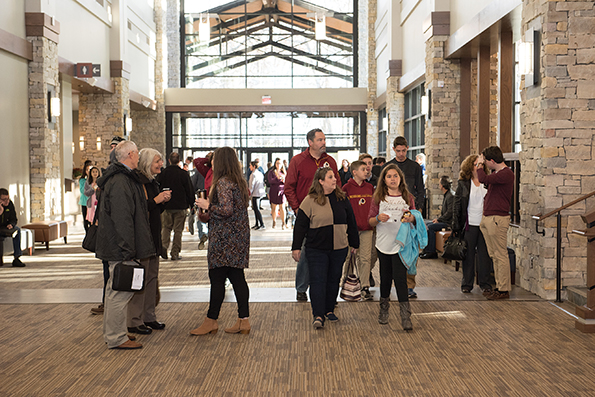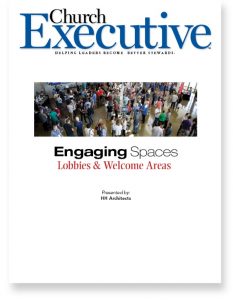
By Mark R Ashcraft with Bruce Woody, AIA
![]() Getting people to engage in today’s fast-paced culture is challenging, with all the competition for attention we carry with us. Yet, at our core, we’re all social creatures seeking connection — real connection.
Getting people to engage in today’s fast-paced culture is challenging, with all the competition for attention we carry with us. Yet, at our core, we’re all social creatures seeking connection — real connection.
As church leaders, we need to break down barriers and create authentic spaces that allow for (and encourage!) this engagement.
In a church lobby or welcome area, there are several aspects — both horizontal and vertical — that create connection. Let’s focus on three key concepts:
#1: First impressions
One of the most influential roles a lobby can play is to make a great first impression. Lobbies have personalities that speak to guests and begin their experience — they need to speak to hospitality. As a person’s first point of contact with a facility, it must send the message: Welcome! We’re glad you’re here.
Incorporating hospitality amenities allows for opportunities for people to connect at a conversational level, to slow down and let down their guard. Ample and varied seating areas give people options to gather and cultivate friendships with people they might have just met.

At Cornerstone Chapel in Leesburg, Va. (shown, left), seating incorporated along the edges of the main commons allows for these quick conversations without impeding traffic flow. A centrally located café with additional seating creates the opportunity for deeper connection — even becoming a destination itself.
The use of glass and natural light is another way to enhance this welcoming feeling. Bright, open spaces feel comfortable, and being transparent is a good way to open doors to the community. Activity begets activity. Being able to see ministry on display invites and draws in curious seekers.
#2: Brand integration
A ministry’s brand should be considered as a design element. This is the easiest way to speak to the community and share a brand story that’s authentic and relevant. Every institution has an established identity that speaks to its core, to its philosophy of ministry. When someone walks into your facility, the building needs to speak the same language as your online and print presence to resonate with their expectations. This creates a more authentic experience.
When Preston Trail Community Church in Frisco, Texas (above) decided it was time to relocate to continue its growth, one of the concerns was maintaining an established identity as a highly creative, community-driven warehouse church. The design of the building references this identity, and specific elements throughout the campus help recall this vision to the average guest.
#3: Wayfinding
At their core, lobbies are connecting spaces. They move people from one space to another. To be effective, this should be an intuitive process. Both first-time guests and longtime members should be able to orient themselves and easily navigate the space.
 Architectural elements, lighting, seating groupings, finishes, materials and more can all be used to provide visual clues, along with well-placed signage.
Architectural elements, lighting, seating groupings, finishes, materials and more can all be used to provide visual clues, along with well-placed signage.
North Dallas Community Bible Fellowship Church in Plano, Texas (pictured, right) never had a significant lobby space before its current campus — just a maze of corridors. This was addressed by making the primary spaces accessible from a single, large commons across the front of the campus. No matter the door you enter, where you’re looking to go is visible.
With proper wayfinding as a guide, lobbies can move people through a space during turnover between services, as well as provide areas to stop and connect. These two functions might seem opposed to each other, but a great lobby allows for both. It enables a sense of control at the user level, ultimately making guests feel more comfortable as they make spontaneous connections on their terms.
By providing a strong first impression aligned with your unique brand and a well-planned design, you create a welcoming environment, setting the stage for connection to happen. We’re called to fellowship in Christ and share the good news — we can start by removing our barriers and proclaiming: Welcome! We’re glad you’re here!
Mark R Ashcraft is a senior associate of HH Architects in Richardson, Texas. He serves as the Creative Director for the firm and has been blessed to work with many ministries during his 16-year tenure.
Bruce Woody, AIA, is president & CEO of HH Architects. He speaks around the country about the importance of campus master planning and has been working with ministries for more than 30 years.


